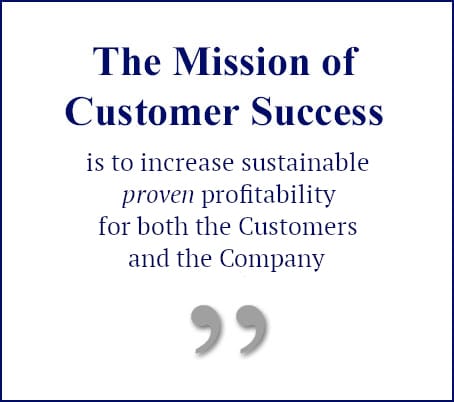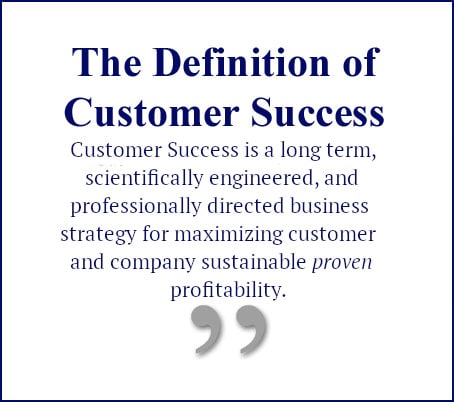Company change is often the elephant in the room. Whether you have an existing and evolving Customer Success (CS) team, or are building an organization for the first time, it’s likely that you have experienced the realities of change management: It is uncomfortable, but necessary to achieve the intended business outcomes. Perhaps you are tasked with taking on direct revenue responsibility, and redefining your existing team’s charter. Or, perhaps you have been hired to build a brand new team from scratch. Regardless of the scenario, you are the promise maker, but also have to be the promise keeper: Your company, and your team, is looking to you to lead transformational change in a way that’s impactful and lasting.
In my nearly 20-year career, I’ve built teams from scratch, I’ve driven global team reorganizations, and I’ve launched new standard operating procedures that radically changed and improved CSM behaviors. With multiple studies published showing that only 33% of change programs succeed, I had to be intentional about my efforts to mitigate failure. I aimed to be a leader that addressed what Harvard Business Review calls the “hard factors” of change management initiatives. There were times where I’d failed as a leader, and times where the project’s success catapulted my career to promotion. The sum of these experiences are summarized in four key learnings:
ONE | Foster Clarity
When igniting transformational change, start by having level-setting conversations with the project’s participants to foster the clarity of the mission. While you have been planning and thinking through your improvement roadmap, your team may not yet have the same level of understanding. In fact, your team may even lack awareness of the problem that needs to be solved. Set the foundation for the business case up front, providing clarity on what will come next and why.
Another way to ensure clarity during change management is to establish a steering committee – and keep it a lean team. According to the Project Management Institute (PMI), a project steering committee (PSC) often plays a significant role in a project’s realization by having a unified group of diverse perspectives who ensure that the project is delivered in scope and on time. Engage multiple stakeholders and subject matter experts from around the company, but limit the group to no more than 6-8 participants. With fewer people, communication will flow more readily, and decision-making can be more nimble.
TWO | Keep It Simple
About three years ago, I was part of the cross-functional steering committee tasked with a “customer loyalty” initiative at a B2B SaaS company. The goal was to increase the company’s net promoter score (NPS) and the executive sponsor and driver of the project suggested that introducing new customer loyalty initiatives would yield an improvement in the voice of the customer survey. We spent every Tuesday evening for months, meeting to brainstorm ideas, delegate new tasks, and obtain status updates on existing tasks. Unfortunately, we had moved far from the core purpose of the project. While we started off strong, discussing time-to-value and improved implementation strategies, our focus dissipated as we were swept up by the impact that a parallel finance & accounting project had on our customers. I’ll spare the details about how I was reviewing invoice language relative to the messaging in the payment portal. However, I will share that we should have paused to reflect and realize that we’d veered from the mission’s path.
To make lasting change, continually come back to the “why” for the transformation: What is the problem that we’re trying to solve? How are we going to solve the problem? One way to stay focused on the mission is to simplify the mission. Ensure that corporate-level objectives and key results (OKRs) are defined, so everything else should map to them. OKRs are to company growth what a North Star Metric is to product development. These important strategies must be S.M.A.R.T. goals (Specific, Measurable, Actionable, Relevant, & Timely) that drive your company forward. All along the way, ask yourself, “Does this support one of our OKRs?” If the answer isn’t a resounding “yes” then it doesn’t warrant time invested. Avoid over-complicating the mission by deviating from the primary goal.
THREE | Bring in Experts
More recently in my career, I’ve leveraged the benefits of outside consulting firms to bring objectivity to change management initiatives. When there was a need to align pre- and post-sales teams to drive top line annual recurring revenue (ARR) flow, we brought in a coaching firm to define a cross-functional team playbook. We walked away with a clear customer journey map, defined roles, and responsibilities, all driving us toward the company objective of gaining and retaining our customers.
Leveraging experts on another project proved helpful for the company’s bottom line [and my own sanity!]. After a failed customer support ticketing software implementation, with a lackluster professional services engagement to course correct, I knew I had to look elsewhere for unbiased input. We engaged a firm with domain expertise in the full suite of technical support strategies and best practice tactical configuration. In four weeks, we were able to remediate the errors of our failed four-month implementation and deploy progressive optimizations that supported our divisional OKRs. Not only did the external consulting firm fill an in-house expertise gap, but their managed service offering also plugged the hole of a time
In both scenarios, the incremental cost of third-party consultants was worth the investment to protect what was impacting the customer experience and long-term annual recurring revenue. While I’d like to think I’m a trend-setter, data suggests that leveraging technology management consultants is a business staple that is here to stay: industry revenue is expected to grow 8.6% in 2021, despite the post-2020 economic recovery.
FOUR | Keep the Customer at the Center of Everything
Lastly, and most importantly, change management in customer success must literally be all about the customer. The function of customer success exists in pursuit of customer retention and losing sight of that during transformational change renders the mission moot. By keeping the customer at the center of all phases of the change management process, you will be equipped with the right motions to execute with clarity & simplicity.
The best way to put this mentality into practice is to create an aligned company culture that champions the customer’s intended business outcome(s). Within the last five years, most B2B SaaS companies have established some flavor of a customer success manager (CSM) role where “customer success” is a department and/or practice area. This upward trend of attention to customer success as a growth engine delights my colleagues and I who “geek out” about our professional passion. However, customer success is more than a box to be checked on a functional organizational chart to impress potential investors and is more than a tool to help with prospective customer sales pitches. Customer success is a philosophy and should be woven throughout any transformational change program to yield true business impact.
SUMMARY
With technology accelerating at an uncanny pace, and customer sophistication evolving rapidly, change is evergreen. With intentional and thoughtful planning, transformational change can be a pleasant and productive experience for all. However, simply having the Customer Success Manager function doesn’t equate to stellar customer centricity. Similarly, having a well-appointed steering committee, nor a fancy “big four” consulting firm partner doesn’t guarantee a successful transformational change. Rather, it’s the combination of (1) having the business need clearly articulated in a way that is (2) easily understood, whereby (3) outside expertise is commissioned to augment internal knowledge and foster objectivity, and (4) customer centricity is the company-wide theme song. When these pillars of transformational change management are realized, only then did I find success in achieving the intended business outcomes.
For additional resources about change management I recommend reading:
- “Build Up Your Team to Build Out CX” to learn strategies to keep the customer at the center of your efforts. By keeping your team top of mind, the customer will be nurtured as well.
- Harvard Business Review’s “The Hard Side of Change Management.” This piece sounds daunting, however it provides four key factors that can predict a project’s success. And the formula has statistically held up for nearly 20 years.
.
Sabina Pons:
 Sabina is a management consultant and educator at Growth Molecules, a consulting firm that helps B2B SaaS companies simplify customer success with actionable processes and scalable programs. With a 20-year career in global CS and CX, Sabina is known for building teams from start-up to grow-up, for scale via client adoption, expansion, retention and loyalty programs. She has earned her MA in Communication & Leadership from Gonzaga University, and her BA in Public Relations from the University of Southern California, and is co-writing a book about working moms in technology.
Sabina is a management consultant and educator at Growth Molecules, a consulting firm that helps B2B SaaS companies simplify customer success with actionable processes and scalable programs. With a 20-year career in global CS and CX, Sabina is known for building teams from start-up to grow-up, for scale via client adoption, expansion, retention and loyalty programs. She has earned her MA in Communication & Leadership from Gonzaga University, and her BA in Public Relations from the University of Southern California, and is co-writing a book about working moms in technology.








